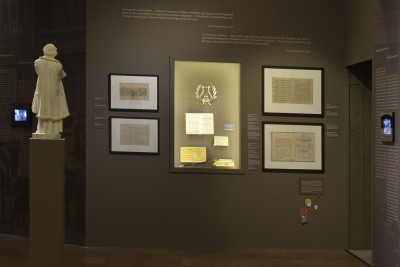- Hitre, tudásra: A piaristák és a magyar művelődés
(Budapesti Történeti Múzeum, Vármúzeum, 2017. november 15.–2018. február 28.)
|
A zene helye a piarista intézetekben elsősorban a templom kórusa volt. A 20. században sok helyen külön zenetermet is berendeztek. Kalazanci Szt. József iskolái azért gondoskodtak a diákok zenei képzéséről, hogy ezzel emeljék a templomi liturgia fényét, illetve hogy a szegény diákok zenei tudásukkal is meg tudják keresni kenyerüket. A piarista templomok zenéjét tehát maguk a piaristák és diákjaik szólaltatták meg. A rendnek sok képzett zenész tagja volt, akik kórusvezetőként, orgonistaként, hegedűsként, fuvolásként, sőt akár zeneszerzőként működtek. Gondoskodtak az utánpótlásról, a szerzetesnövendékek zenei képzéséről is. A tehetséges diákokkal kezdettől fogva külön foglakoztak. A 19–20. században szinte minden gimnáziumnak volt komoly (fiúszólamokból álló) énekkara, zenekara, sőt néhol fúvószenekara, amelyek iskolai ünnepségeken és jótékonysági előadásokon léptek föl. |
The place of music in the Piarist institutes was primarily the choir of the church. In the 20th century music rooms were also installed in many places. The schools of St. Joseph Calasanz provided music training for students to raise the splendour of church liturgy and to allow poorer students to be able to earn their living with their musical talent. Thus the music in Piarist churches was carried out by the Piarists and their students themselves. The Order had a lot of members who were trained musicians and who worked as choir conductors, organists, violinists, flute-players or even composers. They also cared for the musical education of new clerical generations. They worked separately with the talented students from the beginning. In the nineteenth and twentieth centuries, almost every secondary school had a significant choir (consisting of male vocals), an orchestra, or even a brass band featuring school festivals and charity performances.
|
Zenélő és éneklő piaristákról és diákjaikról készült fényképek
